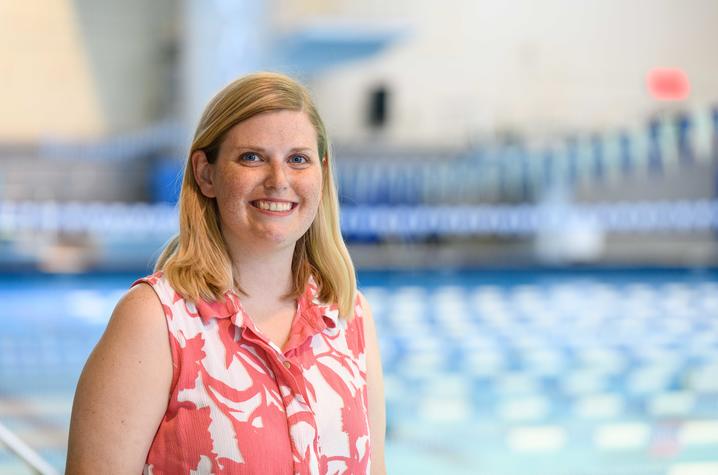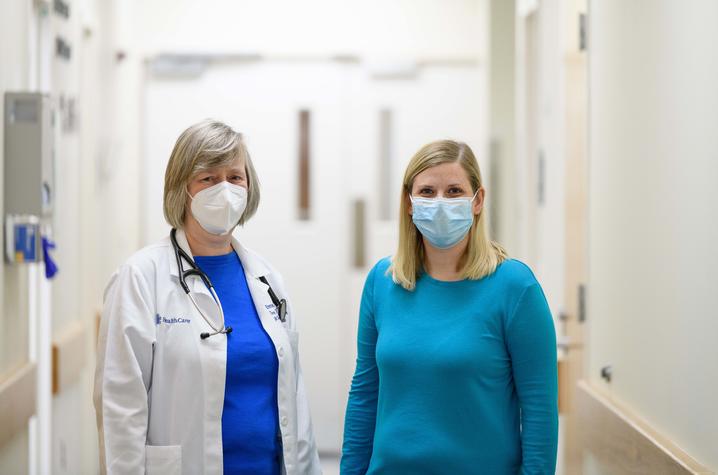'It's the Best Feeling' — Swimmer Back in Action After UK, LVAD Saved Her Heart
LEXINGTON, Ky. (June 8, 2022) — In 2019, Alayna Benningfield was living her dream.
At age 24, she was living in Hilton Head, South Carolina, meeting people from around the world at her job at a beachfront hotel. She had always wanted to work in hospitality and live by the beach. Benningfield spent her downtime swimming in the ocean and hanging out on the beach with her husband, Josh. Life was perfect.
Until she got sick.
“I was tired and getting physically sick,” Alayna said. “It started out once a week. I would be on my way to work and I’d have to pull the car over, be sick, then continue on to work.”
The vomiting continued, increasing in frequency to twice a week, then to every other day ,until she started becoming sick every day for hours at a time.
To this day, Alayna and her doctors aren’t sure what was the catalyst for this prolonged period of illness. Around Labor Day in 2019, Alayna and Josh left Hilton Head for a week during a hurricane, returning home to Elizabethtown, Kentucky. That’s when Alayna said the mysterious illness hit its peak and she was admitted to Baptist Health Hardin.
The doctors' conclusions were inconclusive. They suspected she had possibly been exposed to some kind of virus. By the time she was admitted to the hospital, all traces of a virus were long gone, but not before causing severe damage to her heart. Alayna was referred to UK HealthCare’s Gill Heart and Vascular Institute where she was initially told her only hope was a heart transplant.
“It was a very difficult time,” Alayna said. “I was very angry because I work in hospitality, and I had gotten this dream job by the beach. It was everything I wanted. And I was forced back to Kentucky and was in and out of hospitals.”
Heart transplants can be difficult for someone as young as Alayna. Under ideal circumstances, a transplanted heart only lasts about 15 years, so at some point Alayna would have to be transplanted a second time. And as an avid swimmer and world traveler, she would have to take precautions for the rest of her life, as transplant patients have weakened immune systems and are very susceptible to infections and illness.
But then along came Emma Birks, M.D.
In 2019, Birks left a Louisville hospital to join UK HealthCare's Gill Heart and Vascular Institute; Alayna was one of her first patients. As luck would have it, Birks came to UK HealthCare with significant heart failure treatment experience and research. She had an idea, but first, she had a diagnosis.
“Alayna’s heart has been enlarged for a long time, but she’s young and healthy so she could compensate for it,” Birks explained. “But then someone like her gets some kind of infection on top of that which tips her over the edge and the body can’t keep up.”
If the heart was small, Birks explained, then the symptoms could have been caused by a virus. But Alayna’s heart was enlarged suggesting that the damage had been occurring for a long time, to the point that she was experiencing heart failure. The failure was on the left side, which led to back pressure on the right side of the heart, which can cause fluid to build up in the liver. This is what caused Alayna’s near-constant vomiting.
“She presented as quite severe,” Birks said. “Her heart was quite bad at the time. Patients like her often get diagnosed as other things. I’ve had people diagnosed as appendicitis because no one expects them to have heart failure that young.”
Ejection fraction is a measurement of how much blood leaves the heart with every contraction. A healthy ejection fraction is between 50-75%.
Alayna was at 6%.
“There was a lot of discussion about doing a heart transplant,” Birks said. “Transplant can have great outcomes, but if you commit them to transplant, Alayna would have to have another in 10 to 15 years, and she’s too young for that. And then there’s the ability to wait for a transplant, and she was too sick to wait. But she’s someone who I thought potentially had the capacity to recover her heart.”
Birks floated the option of implanting Alayna with a left ventricular assist device, or LVAD. The LVAD helps the left ventricle, the main blood pumping chamber of the heart, move blood to the rest of the body. It is lifesaving and often used as a therapy for patients who are on the transplant list, particularly those not responding to heart failure medications.
Having conducted significant LVAD research in her native England, Birks found that when patients implanted with the LVAD have their blood pressure supported with the pump, they can tolerate medication that they would not have before due to their low blood pressure and struggling renal function. With the support of the LVAD, this can be used to shrink and recover the heart. Essentially, the LVAD mechanically circulates the blood while allowing the heart tissue to rest, recover and be treated.
“On the LVAD, all of sudden, patients have better flow and blood pressure," Birks said. "So, we were able to use an aggressive medical therapy to try and shrink her heart and improve its function.”
To Alayna, the LVAD wasn’t an ideal solution, but it was worth trying.
“I swam competitively in high school, so the LVAD was terrifying because I couldn’t swim with it,” Alayna said. “But with a transplant, you have to be careful anyway. We figured the LVAD could get me to a point where I would only need one transplant and not have to do two. So, after talking about it with my family, we figured we had nothing to lose.”
In October 2019, in a long and complicated surgery performed by Rajasekhar S. R. Malyala, MD, Alayna’s LVAD was implanted. She quickly found that the pump and its accoutrements brought unexpected challenges.
The LVAD is implanted in the heart and controlled by a battery outside the body. The tube that connects it to the battery comes out of the stomach, something Alayna was abruptly reminded of when going through doors.
“In addition to the constant worry of infection, if I’m not careful, I’ll walk too close to a doorway and the cord would get hooked on a knob and pull it," she said. "Showering was a long ordeal because the batteries can’t get wet. I always had to be sure I had my batteries, and my backup batteries. I couldn’t sleep on my stomach and had to be plugged into the wall. My in-laws bought us a generator so we could charge the batteries if we ever lost power.”
The weirdest part for her? Alayna didn’t have a pulse.
“The LVAD doesn’t beat, it rotates," she said. "At night, you could hear the machine churning. And I didn’t have blood pressure. My primary care providers would say they couldn’t get a blood pressure reading, and I’m like, yeah, I know.”
***
For the first six months she had the LVAD, Alayna remained on the list for a heart transplant, but a suitable match never came up. In follow-up appointments, Birks would turn down the LVAD and test Alayna’s heart function. At first it was just a few minutes at a time, performing echocardiograms to check her heart function. Then, over the course of months, Birks and Alayna’s care team would turn the LVAD down even lower and have Alayna walk for a few minutes on a treadmill.
“Her heart showed slow but steady improvement,” Birks said. “The blood goes back through the aortic valve instead of the LVAD, and the heart starts taking over. We felt she was ready to have it removed.”
Birks conducted significant research on LVADs and has compared patients who took the LVAD removal route to those who had heart transplants.
“We compared the two groups and found the survival was just as good in the LVAD recovered patients, and they were doing better with better quality of life,” Birks explained. “Their kidney function was better because they weren’t on the transplant drugs. Transplant patients are at risk for a number of complications, such as developing transplant coronary disease. The LVAD explant group were doing very well and usually have pretty active lives. It’s a particularly good option for young people that you don’t really want to transplant at such a young age.”
In July 2021, surgeon Malyala operated again, and the LVAD was disconnected and permanently turned off. The tube that ran through her abdomen was clamped shut. And because removing the pump itself from her heart would be risky and complicated, it is still inside her chest, lying dormant.
“They essentially disconnected it and made sure that no blood could flow through it,” Alayna explained. “My heart just pumps around it.”
For the first time in 21 months, Alayna felt her heart beat. And she couldn’t wait to get back in the pool.
“I was a competitive swimmer, so I had this expectation that I was going to get in and swim 30 laps and it’s going to be great,” she said. “But after one lap, I was so tired. I try to go to the pool weekly and gradually increase the number of laps and get stronger. But it’s the best feeling. I was able to have a swim party on Labor Day with my friends and family. I got in the pool and swim with the kids. And it was just the best feeling ever.”
***
Alayna made a few changes to her diet to keep her heart healthy, but she’s back to work full time in a new position at Four Roses Distillery. The experience helped her realize that being home with her family in Kentucky was where she wanted to be.
“I think it brought my family closer together,” Alayna said. “I was drifting off, wanting to move away and live somewhere else, but this really helped me refocus and realize that family was what was important. Work will come and go, but here with family was where I needed to be.”
Alayna is now an advocate for the LVAD, especially in younger people like her experiencing heart failure.
“I think you should take any chance you can get to keep your own heart,” she said. “And the LVAD is a great way to do that. I wouldn’t have chosen the LVAD until I met with someone my age who had an LVAD. It changed everything, being able to see somebody who actually went through it and know that it’s not going to change everything about my life. I could still be home with my family and sleep in my own bed instead of a hospital. It was nice to get that perspective.”
Would she want to do that? Offer to share her experience with someone who was going through what she went through? Alayna lights up with a thousand-watt smile.
“In a heartbeat.”
As the state’s flagship, land-grant institution, the University of Kentucky exists to advance the Commonwealth. We do that by preparing the next generation of leaders — placing students at the heart of everything we do — and transforming the lives of Kentuckians through education, research and creative work, service and health care. We pride ourselves on being a catalyst for breakthroughs and a force for healing, a place where ingenuity unfolds. It's all made possible by our people — visionaries, disruptors and pioneers — who make up 200 academic programs, a $476.5 million research and development enterprise and a world-class medical center, all on one campus.






